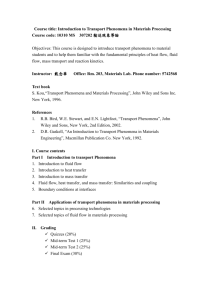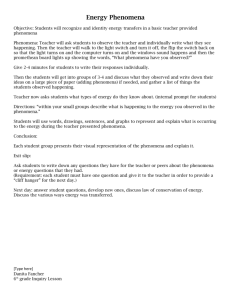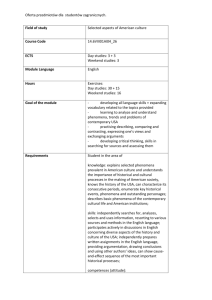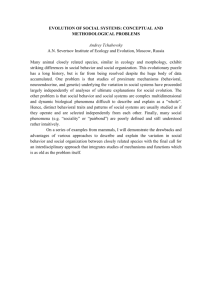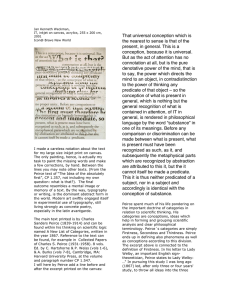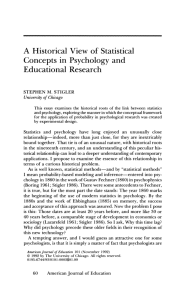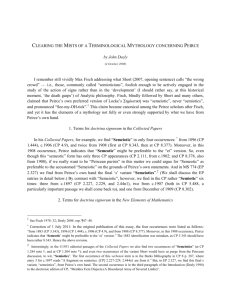Phenomenology - Valdosta State University
advertisement
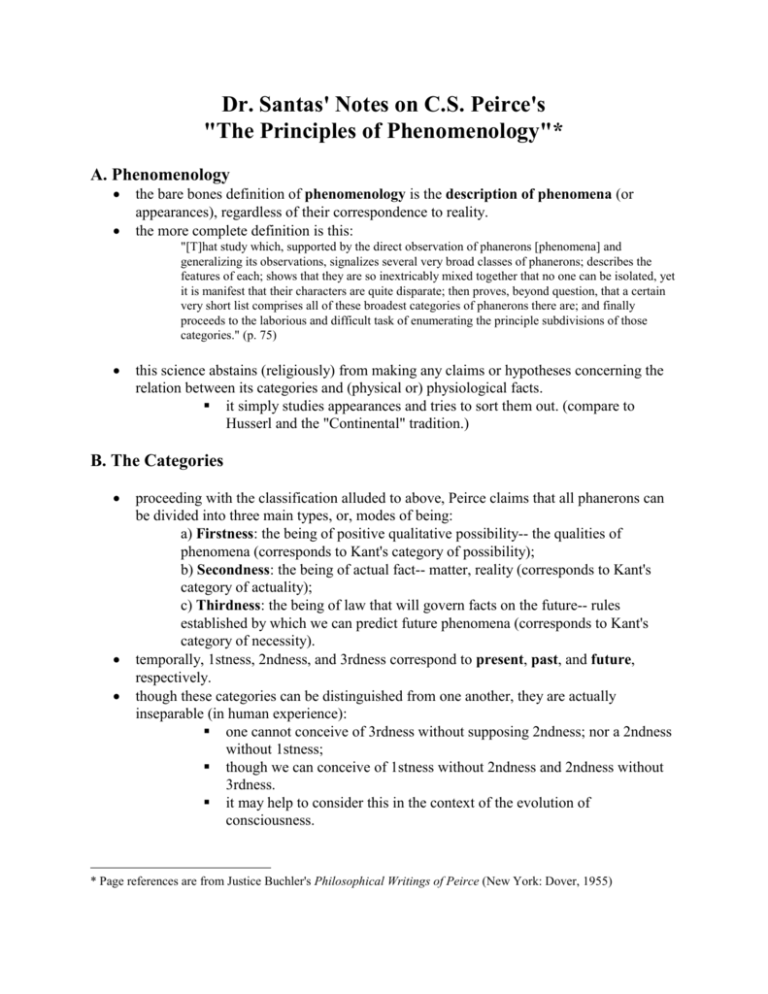
Dr. Santas' Notes on C.S. Peirce's "The Principles of Phenomenology"* A. Phenomenology the bare bones definition of phenomenology is the description of phenomena (or appearances), regardless of their correspondence to reality. the more complete definition is this: "[T]hat study which, supported by the direct observation of phanerons [phenomena] and generalizing its observations, signalizes several very broad classes of phanerons; describes the features of each; shows that they are so inextricably mixed together that no one can be isolated, yet it is manifest that their characters are quite disparate; then proves, beyond question, that a certain very short list comprises all of these broadest categories of phanerons there are; and finally proceeds to the laborious and difficult task of enumerating the principle subdivisions of those categories." (p. 75) this science abstains (religiously) from making any claims or hypotheses concerning the relation between its categories and (physical or) physiological facts. it simply studies appearances and tries to sort them out. (compare to Husserl and the "Continental" tradition.) B. The Categories proceeding with the classification alluded to above, Peirce claims that all phanerons can be divided into three main types, or, modes of being: a) Firstness: the being of positive qualitative possibility-- the qualities of phenomena (corresponds to Kant's category of possibility); b) Secondness: the being of actual fact-- matter, reality (corresponds to Kant's category of actuality); c) Thirdness: the being of law that will govern facts on the future-- rules established by which we can predict future phenomena (corresponds to Kant's category of necessity). temporally, 1stness, 2ndness, and 3rdness correspond to present, past, and future, respectively. though these categories can be distinguished from one another, they are actually inseparable (in human experience): one cannot conceive of 3rdness without supposing 2ndness; nor a 2ndness without 1stness; though we can conceive of 1stness without 2ndness and 2ndness without 3rdness. it may help to consider this in the context of the evolution of consciousness. * Page references are from Justice Buchler's Philosophical Writings of Peirce (New York: Dover, 1955) C. Firstness this category concerns that aspect of phenomena that is purely qualitative-- raw feelings. such feelings of qualities occur only in the instantaneous present; examples include: feelings of pleasure, pain, love, delight, sensations of colors, touch, sounds, tastes... Peirce considers what feeling is: a kind of consciousness not subject to analysis, comparison, or process, has no parts, and is entirely self-contained; it is not an event, or coming-to-pass; it's a state; it is a quality of immediate consciousness. next quality is discussed: it is not dependent on mind or on the fact that some being possesses it (such are the errors of the conceptualist and the nominalist); it is a unitary (i.e., monadic) indivisible aspect of phenomena. 1stness, then, is the monadic element in our world—it’s just there. D. Secondness this category concerns that aspect of the world that resists our will-- the bumpings-into (makes us say oh-oh). they occur as completed actions in the past that we are reacting to in a struggle to get along in the world. examples include: the sheriff's hand on my shoulder, a punch in the nose, a car that won't start, a loud sound that startles us... whereas 1stness concerned feeling and sensation, 2ndness concerns experience: experience is always in some sense reactive, or, rather, interactive; experience involves effort, as we try to do something to the appearing phenomena (like sort them out); 2ndness primarily concerns fact, and we can understand facts in this manner: facts are not general or lawful; they are particular and lawless; facts are brute force, force without law, lawless struggle. 2ndness, then, is that aspect of phenomena that confronts us and elicits a reaction (the polar sense). E. Thirdness this category concerns that aspect of the world which is regular and predictable-- the reason in things. it occurs as a pro-tension towards the future; examples include: (deliberate) conduct, continuity, laws, thought, meaning, growth... 3rdness is mediation, meaning in the full sense of the word: it is the thread running through any process; it is the molding of future reactions (interactions). meaning (3rdness), says Peirce is irreducible to quality (1stness) and reaction (2ndness): first of all, meaning is a triadic relation, and conversely, every triadic relation involves meaning: for all forces occur between things; and all triadic relations involve something like thought. secondly, triadic relations are irreducible to dyadic ones: for meaning always involve someone (1) meaning something (2) to someone else (3). 3rdness, then, is that aspect of phenomena that allows us to bring order to the future. F. Mistaken Categories of Tradition Peirce is convinced that these are the only true categories of phenomena, and that our ideas of them arrive by virtue of congenital tendencies of the mind. the latter claim sounds Kantian, and is, to a certain extent; but Peirce's division of the categories is in opposition to Kant's: Kant separated the mind into three faculties: Feeling, Knowing, and Willing: Peirce disagrees (see p. 94): a) the relationship between will, desire, and pleasure shows overlap between these faculties; b) feeling should not be identified with pleasure and pain, since these are judgments--reports of feeling; c) cognition is involved in all phenomena: emotion, passion, will.





